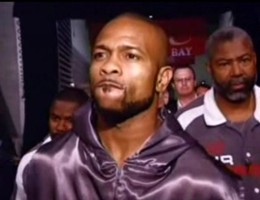 11.09.07 – By David J. Kozlowski: Boxing hit a high point in May with the highly hyped and anticipated Oscar De La Hoya vs. Floyd Mayweather fight. In the weeks following, some boxing analysts criticized the decision-makers of the sport for failing to take advantage of the publicity the high-profile fight generated. Roy Jones Jr., however, got the message and is attempting to capitalize on the attention that De La Hoya vs. Mayweather brought to boxing.
11.09.07 – By David J. Kozlowski: Boxing hit a high point in May with the highly hyped and anticipated Oscar De La Hoya vs. Floyd Mayweather fight. In the weeks following, some boxing analysts criticized the decision-makers of the sport for failing to take advantage of the publicity the high-profile fight generated. Roy Jones Jr., however, got the message and is attempting to capitalize on the attention that De La Hoya vs. Mayweather brought to boxing.
Announcing retirement in 2005 after losing his second bout with Antonio Tarver, Jones wasted little time, less than a year, in making the traditional boxing comeback against Prince Badi Ajamu. Jones won a unanimous decision against Ajamu, then boxed Anthony Hanshaw to the same result.
Now Jones, 38, tackles his toughest comeback opponent yet—an aging Felix “Tito” Trinidad who, at 34, is also out of retirement and coming off an unimpressive loss to Winky Wright. Jones has said, “The sport needs another megafight and that’s what this is.” Whether it is or not, both Jones and Tito are well-known names in boxing circles. Their wider popularity, at least in Jones’s case, is questionable.
This isn’t lost on Jones. To further his celebrity and broaden his appeal, in August, Jones became an honorary member of Tau Kappa Epsilon Fraternity. TKE is the largest social fraternity in the world with a presence on almost 300 college campuses in North America, and an initiated membership of over 220,000. This is an interesting marketing strategy for the self-promoted Jones—give the guys in college a reason to watch boxing. The “hey, that’s our fraternity brother” crowd could provide a buzz among a demographic that currently seems more interested in video games and drinking games—18 to 23 year old college students.
Maybe more boxers should follow Jones’s lead. Affiliating with a fraternity that exists on hundreds of college campuses provides an established fan-base of men who likely already watch sports. This could lead to wide word of mouth advertising in university circles, and could generate more buzz and attention to the boxer and to the boxing in general in the United States, which could use the help.
Boxing’s U.S. popularity has been waning, especially with the recent increases in mixed martial arts viewership. For boxing to regain some of its former glory in the American consciousness, it needs to be marketed to a younger generation, which is exactly what Jones is doing. Whether Jones’s move will pay off, only time (or Pay Per View buys) will tell.
Questions and comments can be directed to the author at DKozlowski@gmail.com.